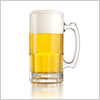Coșul dumneavoastră

 USA: Anheuser-Busch brews up an energy savings process
USA: Anheuser-Busch brews up an energy savings process
Anheuser-Busch brews up an energy savings process, St. Louis Today reported June 15.
The six massive tanks inside the barbed-wire fences are filled with nasty stuff: beer spillage and wastewater sluiced off from the brewing process at Anheuser-Busch Cos.' St. Louis brewery.
The liquid in the 55-foot-high, 375,000-gallon tanks is ripe with organic molecules: yeast, stray bits of grain and other leftovers. But for Anheuser-Busch, the liquid — percolating through mounds of green-black, oxygen-averse bacteria — is as good as money in the bank.
The bilge is valuable because A-B uses a technology it calls "bio-energy recovery systems," or BERS, to pretreat wastewater and wring usable energy from waste nutrients at nine U.S. breweries and two overseas.
The technology allows the company to trim energy costs by millions of dollars — up to $5 million a year in fuel savings at the St. Louis brewery alone. BERS gets rid of solid waste and reduces the strain on local sewage districts. It also slashes emissions of carbon dioxide by an estimated 400 million pounds a year. Advertisement
BERS is "the core of our renewable fuels," said Al Beers, who manages wastewater treatment at Anheuser-Busch's domestic breweries. It even has become a tidy little side business: Over the last two years, the company has sold about 4 million gallons of the "biomass" created in the BERS process to other companies so they can replenish their own energy-capturing systems.
In St. Louis, the process starts when wastewater runs in pipes from the brewery to the BERS facility, which is wedged into a complex next to an old locomotive repair shop near the Mississippi River.
Screens snag large solids such as pieces of spent grain. The filtered water is collected in 1.2-million-gallon equalizer tanks, where temperature and acidity are kept within acceptable ranges.
The wastewater is then sent to airtight reactor tanks. There, anaerobic bacteria — microscopic "bugs" that live without oxygen — swarm around the small organic particles still in the water. The bacteria munch on the organic materials, forming millions of flakes of sludge — or biomass — a few millimeters wide.
The idea is to "make sure (the bacteria) are nice and healthy so they can do their business," said Jeff Pitts, the brewery's manager, during a recent tour of the BERS facility. "All of this … is about happy bugs."
As the bacteria — "the guys," as Pitts calls them — digest the material, they produce methane. The gas is siphoned out of the tanks and back into the brewery, where it helps to fire the boilers that drive the facility's machinery. The newly processed wastewater is sent to the Metropolitan St. Louis Sewer District.
A-B processes an average of 5.5 million gallons of wastewater every day at the St. Louis brewery, its largest. The company says BERS reduces organic waste from its breweries by more than 80 percent. That, in turn, cuts the strain on sewage treatment systems.
From its start more than two decades ago at a New Jersey yeast manufacturing plant, Anheuser-Busch's BERS technology has spread to nine of the company's 12 U.S. breweries, one outside London and one that churns out Budweiser in the city of Wuhan in eastern China.
"Based on its performance, I would still say it's leading-edge technology," said Joseph J. Romm, a senior fellow at the Center for American Progress who wrote about BERS in his 1999 book, "Cool Companies: How The Best Businesses Boost Profits and Productivity by Cutting Greenhouse Gas Emissions."
The system pumps out between 10 and 15 percent of the energy needs for each of the breweries in which it has been installed, amounting to 8 percent of the total fuel needs in the company's U.S. operations. In its most recent environmental report, A-B said it boosted its biogas production by 18.9 percent between 2001 and 2005.
The company is laying plans to install BERS in one of its smallest breweries, a 4.4-million-barrel facility in Fairfield, Calif.
A-B's St. Louis brewery has had BERS technology since 1996, but the system has been tweaked and adjusted along the way. The local testing happens in a noisy pump room, where a miniature BERS set-up tests bacteria under rough conditions — raising the pressure, dropping the temperature, and starving and overfeeding them. The results showed that wastewater could be processed at a wider temperature range than originally thought, helping A-B save energy.
BERS also allowed the sewer district to close down an aeration facility about a year ago, said John Lodderhose, the sewer district's assistant director of engineering for the division of environmental compliance. That move saved the district more than $250,000 in annual electricity costs.
"They're significantly reducing the waste strength," Lodderhose said of Anheuser-Busch.
Înapoi





